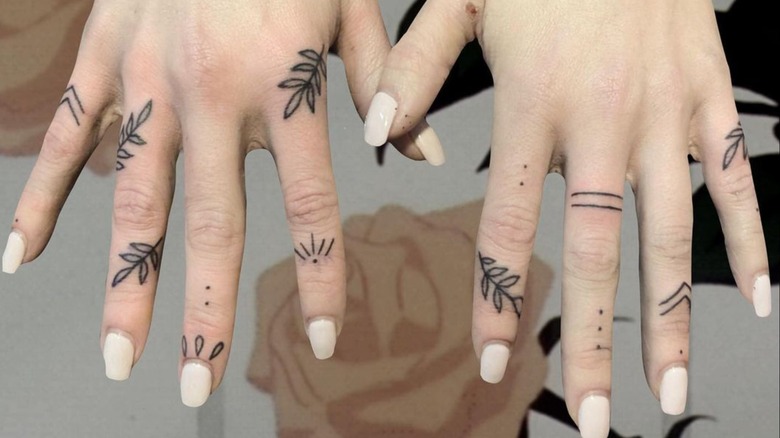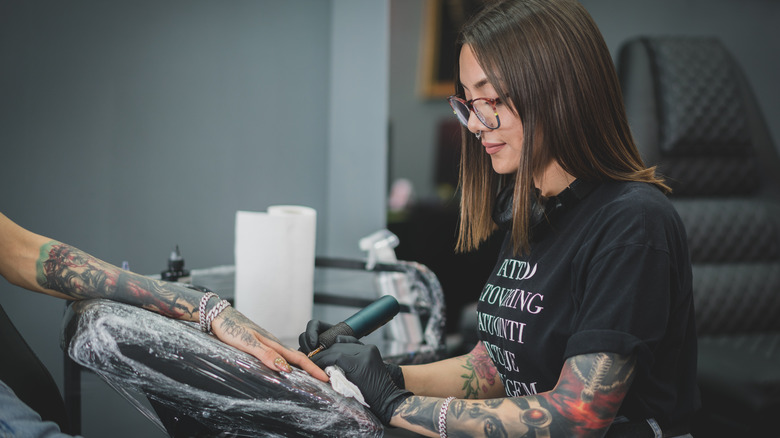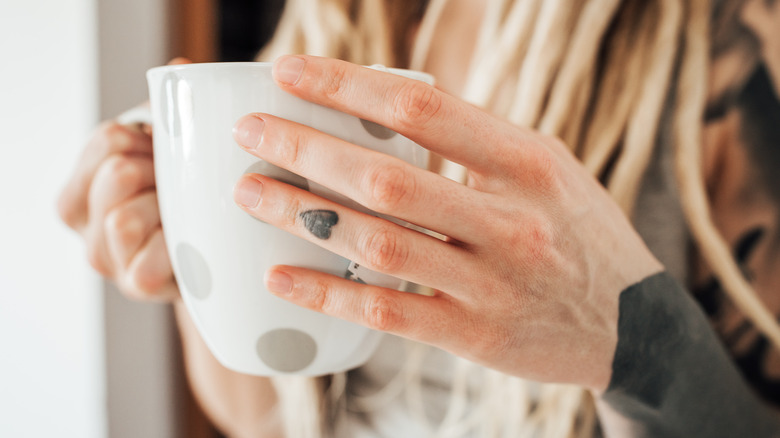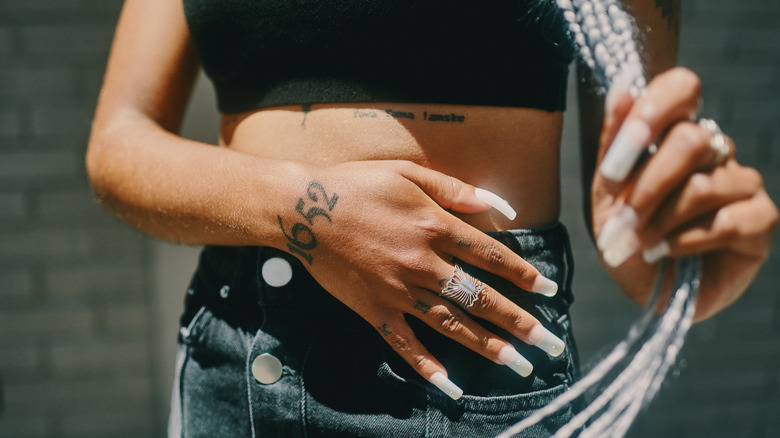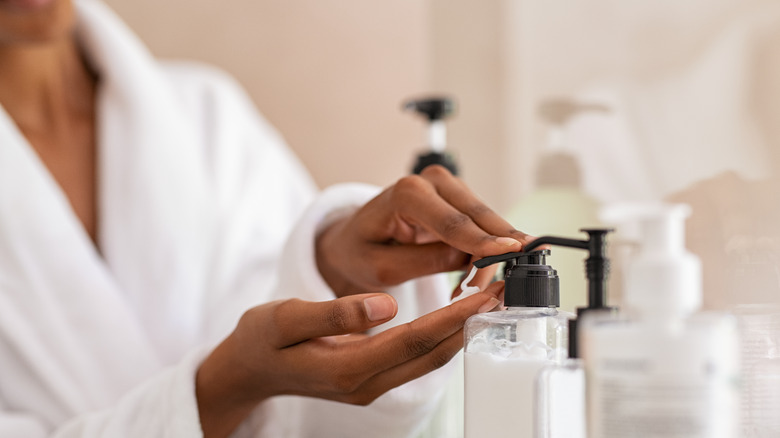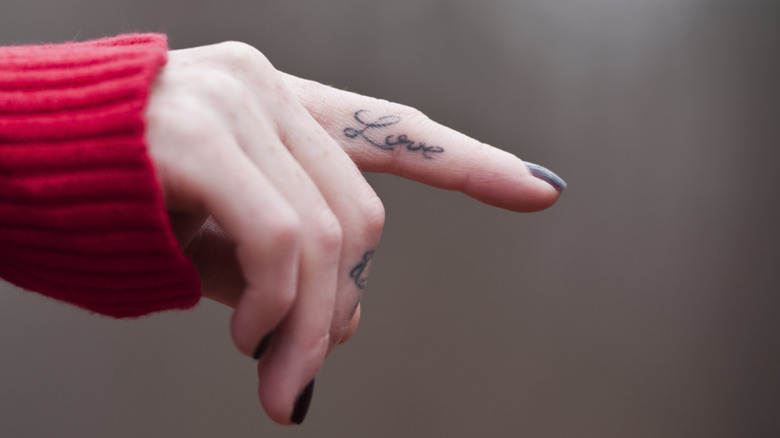A Guide To Finger Tattoos: What To Consider Before Getting Inked
Finger tattoos offer the best of both worlds: They're small and minimalist, yet they make a big statement, given that they're always on display. It's no wonder they're so in demand these days. "With the emergence of fine line and, more recently, single-needle tattooing, hand tattoos are more accessible and more popular than ever," Sol Wright, a tattoo artist based in London and Amsterdam, shared with Metro.
Count Rihanna, Hailey Bieber, and Ariana Grande as just a few of finger tattoos' most famous fans. However, finger tats aren't just a recent trend. (Does anyone recall the hipstery fingerstache tattoo circa the early 2000s?) Now that they've become mainstream, their popularity will likely stay. If you're feeling inspired to get your own digit ink, now's as good a time as ever, though there are a few things to remember before scheduling your appointment.
First, note that your finger tattoo will be highly visible whether you go out with friends or lead a business meeting. Another point: Ink isn't as easy to apply to the fingers as other body parts. "I usually just ask folks what level of a perfectionist they are, and if the answer is high, logic often dictates that we tattoo another area," New York City tattoo artist Gianna Maria Galli explained to PopSugar. Finally, remember that — like most body art — finger tats are a long-term commitment. Get to know the entire process, from getting inked to scheduling touch-ups, to avoid tattoo regrets later.
What to expect from the appointment
Getting a finger tattoo isn't as simple as calling your local tattoo studio and booking an appointment. That's because not every tattoo artist is willing to do them. "Finger tattoos often have a high rejection rate [because of their] high chance of healing with imperfections," Gianna Maria Galli revealed to PopSugar. Celebrity tattoo artist Brian Woo, a.k.a. Dr. Woo, echoed this idea. "It's a really small area, so you have to be nimble with your fingers to make sure you get that ink to stay in the spots that you need it to go in," he explained to Coveteur. "Also, the cracks, the folds, and the thin nature of the finger make the application a little bit tougher than other areas."
This doesn't mean getting inked on your fingers is a lost cause, but you might have to shop around longer than usual to find an artist who's game. When weighing your options, be sure to choose professionals who have experience doing finger tattoos and can confidently answer any questions you have about the process. If you're new to tattoos, expect to start by choosing your design and discussing it with the tattoo artist (this can take place even before you arrive at the studio). Then, your appointment will involve cleaning and prepping the skin, outlining the design on your finger, needling the ink, and finishing off with a protective ointment or bandage.
Are finger tattoos painful?
If your pain tolerance is on the low end of the spectrum, you may want to reconsider — or at least learn some deep breathing techniques to help you cope — before setting up your finger tattoo appointment. According to Healthline, the hands are covered in thin skin and contain a lot of nerve endings, making them one of the most painful spots to get inked. As a result, you may experience excruciating spasms during the tattooing procedure.
The good news, however, is that not all areas of the finger are equally painful, and some people hardly notice any discomfort (especially if they have a careful tattoo artist). "The top of the finger can definitely be less painful than the inside part of your finger," tattoo artist Sydney Smith advised Bustle. "Most clients handle the pain pretty well. My style is definitely a lot lighter and thinner than most, so I don't do too much damage to the skin. Some clients even say they don't feel it at all!"
How to choose your finger tattoo design
Because finger tattoos aren't foolproof, you'll want to choose your design wisely and with the help of a trained tattoo artist. The first matter of business? Location. "The tops of your fingers between the knuckles is the best place for a tattoo," John Reardon, owner of Greenpoint Tattoo Co., told Coveteur. Other finger real estate, such as the pads and knuckles, are more prone to wear and tear over time.
As for the actual design, simple is usually the best approach. Detailed artwork is generally a no-go on your digits, meaning you probably shouldn't copy Cara Delevingne's infamous lion head design. The reason is simple: Finger ink tends to bleed and fade, turning an intricate design into a blurry ink blob.Your best bet is a minimalist tattoo with uncomplicated lines and shapes — think micro hearts, straightforward initials, and basic dot patterns.
Finger tattoo aftercare
Just because you've chosen your tattoo design and gritted your teeth through the pain of getting poked with a needle doesn't mean your work is done. Aftercare is essential to preserving your new ink, especially given how finicky the fingers can be. Expect most healing to occur within the first week or so and for the fingers to heal fully within four to six weeks.
Follow your tattoo artist's post-ink instructions to keep recovery time as short as possible. "As with most tattoos, it is best to keep the area clean and prevent it from drying too much," New York City-based tattoo artist Ron Mor suggested to Allure. "This is usually difficult with hands because we use them so much. A gentle approach is best." Wash regularly with antibacterial soap and follow up each time with a moisturizing antibiotic ointment, advises WebMD. After five days, use a fragrance-free lotion instead, making sure to combat dry skin on your hands for at least two to four weeks.
How quickly do finger tattoos fade?
One of the hardest parts of getting a finger tattoo is keeping it looking fresh. "Finger tattoos are challenging because the skin on our hands is constantly in motion. We use our hands so much, wash our hands so much (now more than ever), that the ink fades fast," Rosa Bluestone Perr, tattoo artist and founder of Bluestone Babe, revealed to Coveteur. "The skin on our hands also regenerates at a much faster pace than elsewhere on our bodies." Translation: The ink on your digits might not age so gracefully without a bit of help.
Usually, the best way to deal with faded tattoos, besides accepting them as they are, is to head back to the studio for touch-ups. This can occur as soon as one month later. "Just to be safe, I normally schedule a touch-up four weeks out after the original appointment just to make sure that everything is in there [is] really solid and even," tattoo artist and owner of Black Amethyst Tattoo Co. Erica Rose told Bustle. "Especially with clients who have their hands in the water like bartenders, hairdressers, waitresses, mechanics, people who are really really active with their hands, I always like to make sure that I see them back in a month just to be safe." Additional touch-ups may be required every few years to keep your lines sharp, though it's just as crucial not to overdo it to prevent ink from looking sloppy.
